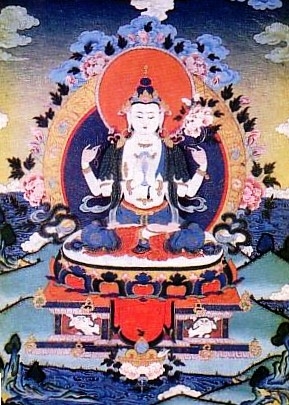Avalokiteshvara

Avalokiteshvara (Skt. Avalokiteśvara; Tib. སྤྱན་རས་གཟིགས་ or སྤྱན་རས་གཟིགས་དབང་ཕྱུག, Chenrezik or chenrezig wangchuk, Wyl. spyan ras gzigs or spyan ras gzigs dbang phyug) is said to be the essence of the speech of all the buddhas and the incarnation of their compassion. As one of the Eight Great Close Sons, he is usually depicted as white in colour and holding a lotus. He is of special importance to Tibetans, so much so that he is sometimes described as the patron deity of Tibet. Among his emanations are King Songtsen Gampo — who is credited with authoring the Mani Kabum, a cycle of teachings and practices dedicated to the deity — as well as the lineages of Dalai Lamas and Karmapas.
Origin Story
Countless ages ago, it is said, a thousand princes vowed to become buddhas. One resolved to become the Buddha we know as Gautama Siddhartha; Avalokiteshvara, however, vowed not to attain enlightenment until all the other thousand princes had themselves become buddhas. In his infinite compassion, he vowed too to liberate all sentient beings from the sufferings of the different realms of samsara. Before the buddhas of the ten directions, he prayed: “May I help all beings, and if ever I tire in this great work, may my body be shattered into a thousand pieces.”
First, it is said, he descended into the hell realms, ascending gradually through the world of hungry ghosts, up to the realm of the gods. From there he happened to look down and saw, aghast, that though he had saved innumerable beings from hell, countless more were pouring in. This plunged him into the profoundest grief; for a moment he almost lost faith in that noble vow he had taken, and his body exploded into a thousand pieces. In his desperation, he called out to all the buddhas for help, who came to his aid from all directions of the universe, as one text said, like a soft blizzard of snowflakes. With their great power the buddhas made him whole again, and from then on Avalokiteshvara had eleven heads, and a thousand arms, and on each palm of each hand was an eye, signifying that union of wisdom and skillful means that is the mark of true compassion. In this form he was even more resplendent and empowered than before to help all beings, and his compassion grew even more intense as again and again he repeated this vow before the buddhas: “May I not attain final buddhahood before all sentient beings attain enlightenment.”[1]
In terms of his future, the Tathāgata Ratnagarbha prophesized:
- You, Avalokiteśvara, will free many hundreds of thousands of millions of trillions of beings from suffering. Noble son, being a bodhisattva, you will accomplish the deeds of a buddha. Noble son, after the Tathāgata Amitābha has passed into nirvāṇa, his Dharma will come to an end at dusk one day in the latter part of the second incalculable eon, in which there are as many years as there are grains of sand in the Ganges River. The following dawn you will attain the complete enlightenment of perfect buddhahood while sitting on a vajra seat, at a Bodhi tree, in a manifold array. You will become the tathāgata arhat samyaksambuddha named Samantaraśmyabhyudgataśrīkūṭarāja.[2]
Forms
Masculine Forms
One Face and Two Arms
- Lokanatha (Tib. འཇིག་རྟེན་མགོན་པོ་, Wyl. 'jig rten mgon po)
- Khasarpana or Khasarpani
- Padmanarteshvara (Tib. པདྨ་གར་གྱི་དབང་ཕྱུག་, Wyl. padma gar gyi dbang phyug)
- Nilakhanta
- Padmapani
- Simhanada (Tib. སེང་གེ་ང་རོ་, Wyl. seng ge nga ro)
- Tailokyavashamkara
- Vajradharma (Tib. རྡོ་རྗེ་ཆོས་, Wyl. rdo rje chos)
One Face and Four Arms
- Chaturbhuja
- Jinasagara (Tib. རྒྱལ་བ་རྒྱ་མཚོ་, Wyl. rgyal ba rgya mtsho)
- Shadakshrilokeshvara (Tib. སྤྱན་རས་གཟིགས་ཕྱག་བཞི་པ་, Wyl. spyan ras gzigs phyag bzhi pa)
- Rakta Lokeshvara
One Face and Eight Arms
- Amoghapasha (Tib. དོན་ཞགས་, Wyl. don zhags)
Three Faces
- Chintachakra
Eleven Faces
- Ekadashamukha (Tib. བཅུ་གཅིག་ཞལ་, Wyl. bcu gcig zhal)
- Sahasrabhujalokeshvara (Tib. ཕྱག་སྟོང་ཞལ་བཅུ་གཅིག་, Wyl. phyag stong zhal bcu gcig)
- Vajragarbha
Feminine Forms
- Guanyin (Chinese)/Kannon(Japanese)
Notes
- ↑ Sogyal Rinpoche, The Tibetan Book of Living and Dying, Appendix Four
- ↑ https://read.84000.co/translation/toh112.html#UT22084-050-003-596
Further Reading
- Bokar Rinpoche, Chenrezig, the Lord of Love (San Francisco: Clearpoint Press, 1991)
- Jamgön Mipham, A Garland of Jewels, trans. by Lama Yeshe Gyamtso (Woodstock: KTD Publications, 2008) (Available as free ebook)
- John Blofeld, Bodhisattva of Compassion—The Mystical Tradition of Kuan Yin (Boston: Shambhala, 1988)
- Tulku Thondup, The Healing Power of the Mind (Boston: Shambhala, 1998), 'Invoking the Buddha of Compassion to Open Our Hearts' in chapter 15.